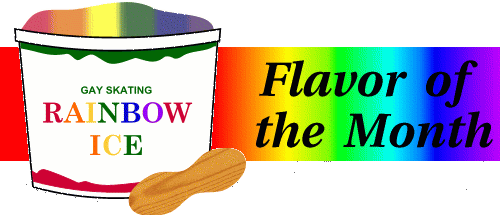

| Graphic by YIKES,Inc. |

When the first volume of Toller Cranston's autobiography, Zero Tollerance, was published, Rainbow Ice contacted the publisher for permission to quote. Cranston's refusal (through a representative), not only to permit the quotation but to be included on the Rainbow Ice site at all, was couched in unprintable terms. Not hostile -- not obscene -- funny and dear, even -- but distinctly unprintable.
Very well; despite being within complete legal rights to list Cranston among élite skaters who are "gay, lesbian, bisexual, or otherwise not heterosexual" (the last being the category to which Cranston most likely belongs, if one must violate le Patineur du Siècle via the indignity of taxonomy), out of respect for his magnificence, Rainbow Ice acceded to his wishes. Cranston, along with the review of the book which included mention of a same-sex affair, was relegated to the FAQ portion of the site.
Here's what Cranston's FAQ entry looked like:
Toller Cranston, 1976 Olympic bronze medalist and six-time Canadian champion, has not to my knowledge declared a sexual orientation. It is my understanding that he would not wish to be classified as a gay or bisexual skater, and I respect that wish. However, he has discussed publicly a romantic involvement with a male South American ambassador in Paris. Read about it, in his own words and in full context, in his complex autobiography Zero Tollerance, co-written with Martha Lowder Kimball.
Now, with the publication of Zero Tollerance's companion volume, When Hell Freezes Over, Should I Bring My Skates?, there is too much textual evidence from the author himself to omit him from the "otherwise not heterosexual" category.
Regarding his love and sex lives, Cranston's main point is that he has not had much of either: "I have been an emotional iceberg for my entire life," he says, on p. 185.
It would be a disservice to When Hell Freezes Over, and its author, to read the book scanning for tales of sexual encounters. Romance is not a significant part of this rich book. Insofar as involvements are mentioned, there are accounts of episodes with men and at least one woman. The closest that Cranston comes to defining his sexuality is when discussing an early mentor and sponsor, Mrs. Odessa Carrion, on p. 9:
"Mrs. Carrion made one particular remark that grabbed me like white-hot tongs around my neck. She said, 'If you do not leave your mother and her influence, you will become a homosexual.'
"I recognized Mrs. Carrion's kind intentions. Nevertheless, with regard to my personality and my brain chemistry, the die had been cast. There wasn't anything she could do to change the person I was, but she saw all the signs and tried very hard to protect me."
On p. 13, when discussing his last meeting with her at Radio City Music Hall in 1983, he concluded, "Everything that Mrs. Carrion predicted for me had come true by then, both the good and the bad." Presumably, this included the prediction that he would become "a homosexual."
On pp. 54-57, Cranston describes falling prey to a probably strategic encounter with reigning world and Olympic champion Ondrej Nepela, at the 1973 world championships in Nepela's hometown of Bratislava. Between soup and the main course of dinner following the men's short program, Cranston alleges that "sly Ondrej Nepela" picked him up for a brief, innocent tryst that left Nepela unaffected, but shook Cranston. Cranston, who had been celibate while training for worlds, was unable to regain his focus after the unexpected encounter. He finished fifth, no competitive threat to repeat winner Nepela.
Perhaps the most achingly frustrating moment of the book comes on pp. 185-187 when Cranston describes a "once-in-a-lifetime idyll" with a man, a German-Swiss actor for whom he harbored a rare crush. Cranston sounds regretful as he tells how a controlling friend cut short their time together.
Regardless of his personal sexual orientation or lack thereof, Cranston leads a life that is matter-of-factly inclusive of all types, and perfectly aware of queer communities. He devotes Chapter 14, "My Sherika," to discussing a friend and artistic mentor, an Emmy-winning hair and makeup specialist who is a male-to-female transperson. "She met and worked with many of the top skaters in the world," he says of her on p. 95; but Cranston's affectionate and respectful discussion of his friend shows far greater understanding of gender identities than any other skater has shown to date in interview or print.
Cranston's one meeting with Liberace occurred, as it happened, three months before the pianist died of AIDS-related illness. On p. 126, Cranston said of him, "His greatest fear, I read in a magazine, had not been death, but that his fans would think he was gay. Was there anyone who could have thought otherwise?"
One might say the same of Cranston: could anyone have thought he was not "other than heterosexual"? With apologies to any sense of reticence, privacy, or ambivalence the artist might have, Rainbow Ice includes him on the site. Too many gay men first understood themselves when watching his iconoclastic skating; he is too great a cultural treasure to withhold from those seeking to understand the "other than heterosexual" aspects of the personalities that make up this sport.